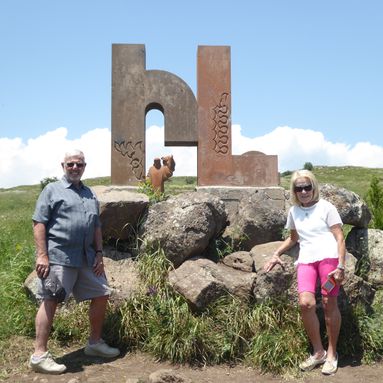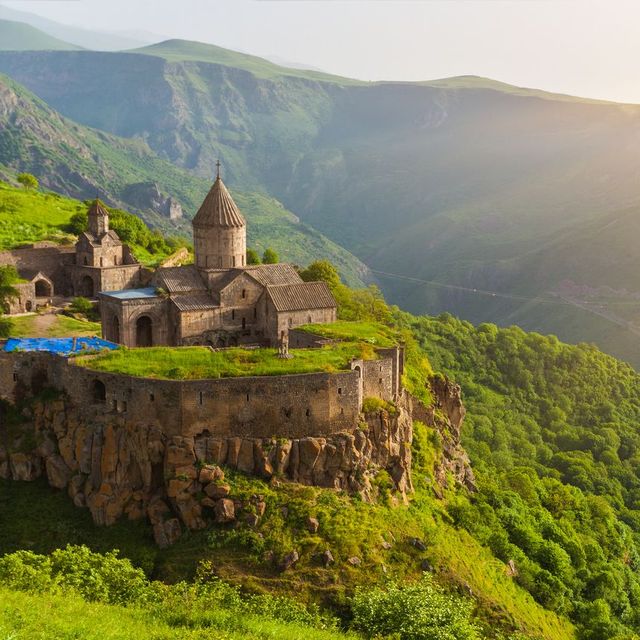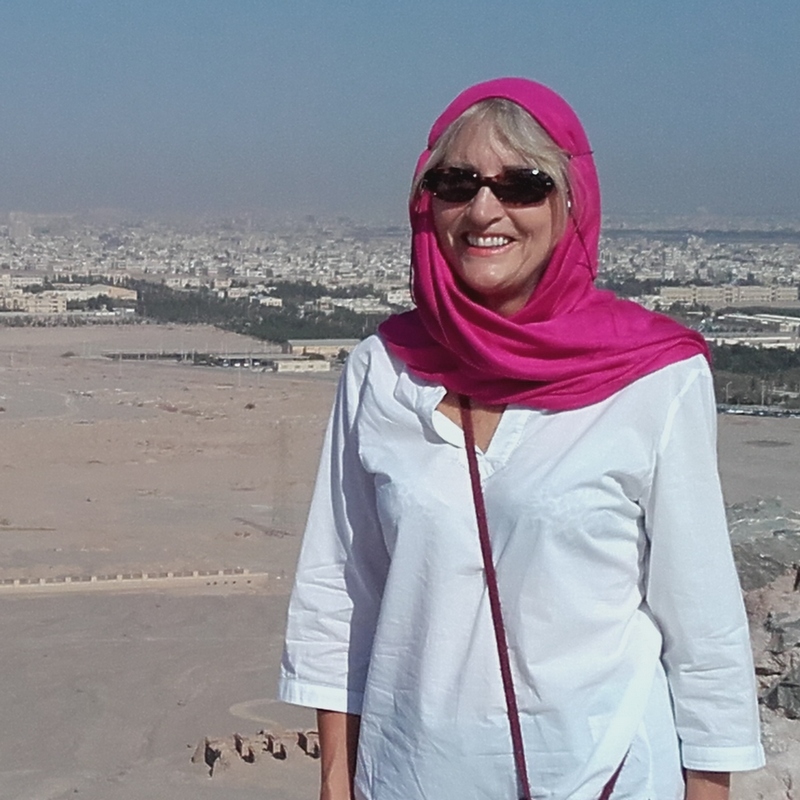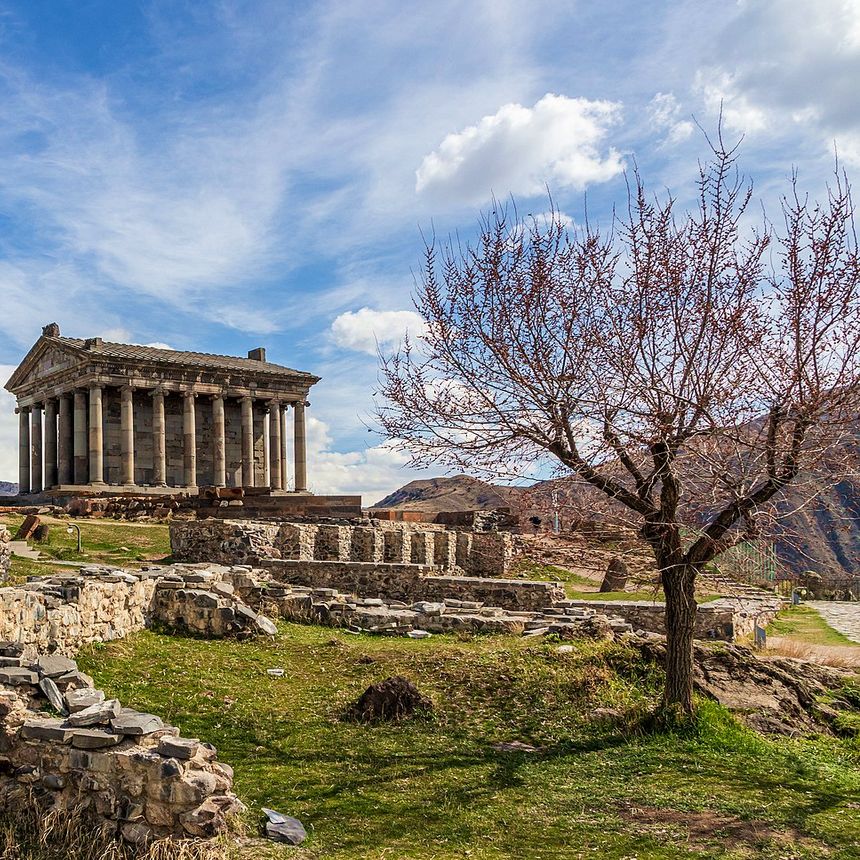
Day 1 : Departure
Depart from your home country on your flight to Yerevan.
Meal plan: n/a
Nestled amongst the mountains of the southern Caucasus, Armenia is often overlooked by travellers, though as the first country in the world to adopt Christianity, there is much to be discovered in its wealth of history and culture. Begin your journey through this fascinating country in the capital Yerevan, tasting Armenia’s famous brandy and learning how to make traditional Armenian cuisine. Marvel at the unique architecture of ancient churches, monasteries and fortresses, from Khor Virap to Noravank, with the stunning backdrop of Mount Ararat’s snowcapped peaks. Discover the ancient cave village of Khndzoresk before taking a ride on the world’s longest cable car to Tatev Monastery. Follow in the footsteps of the Silk Road travellers as you journey through the Selim Pass, and witness the changing colours of Lake Sevan, one of the largest alpine lakes in the world. Visit the Armenian Genocide Memorial Museum, and learn how Armenia has emerged from its tragic past as a country of remembrance and reflection with an optimistic future.
Yerevan - Goris - Khndzoresk - Yeghegnadzor - Sevanavank - Lake Sevan - Selim Pass - Garni

Depart from your home country on your flight to Yerevan.
Meal plan: n/a

Arrive at Yerevan International Airport in the early morning where you will be met by a Travel The Unknown representative and transferred to your hotel. After some rest and a late breakfast at the hotel, begin your walking tour of Yerevan, starting at the Republic Square, the masterpiece of the architect Alexander Tamanian. Continue to the Opera House, a stunning architectural piece and the hub of Yerevan. Freedom Square is just behind, surrounded by parks and outdoor cafes, and finally Swan Lake. Next, visit the Cascade complex, an open-air museum of modern art with huge stairways leading up to the Victory Park where there are fantastic views over the entire downtown. Finally, enjoy a visit to the Brandy Factory. Dinner is served in a traditional restaurant with live folk music. Overnight in Yerevan.
Meal plan: Breakfast & dinner

In the morning, drive to the Vayots Dzor region, the agricultural heart of the country inhabited since the Bronze Age. The region also boasts of its old wine-making traditions, with latest excavations discovering the oldest wine production units in one of the caves. En route, visit Khor Virap Monastery, standing before the snowcapped Mount Ararat. Enjoy lunch in a local house with a cheese making presentation by the host. Proceed to Areni Cave where, in 2008, archeologists found “the oldest leather shoe” in the world (older than both Stonehenge and the Egyptian pyramids!). Continue to the 12th century Noravank Monastery, located in a seemingly inaccessible location amidst impressive red cliffs and stunning mountains. Later, drive south to the town of Goris for your overnight stay.
Meal plan: Breakfast & lunch

After breakfast, explore Goris before enjoying an excursion to the cave village of Khndzoresk. Continue to explore the 10th century monastic complex of Tatev, reached via ropeway along the world's longest cable car. Later, drive to Yeghegnadzor, stopping at Karahunj (Armenian Stonehenge) en route. Overnight in Yeghegnadzor.
Meal plan: Breakfast & dinner

In the morning, drive to Lake Sevan through Selim Pass, visiting the caravanserai. On the way, visit the small lakeside village of Noratous. The village cemetery has one of the largest collections of "khatchkars" (carved stone slabs bearing crosses and other religious motifs) dating back to between the 7th and 10th centuries. On arrival at Lake Sevan, visit Sevanavank Monastery, sat on the peninsula with stunning views over the lake. Overnight near Sevan.
Meal plan: Breakfast & dinner

After breakfast, continue to the village of Garni and its pagan temple. Afterwards, accompanied by a local hiking guide, proceed to Garni Gorge and the Symphony of Stones (1.5 hrs easy hike). Northeast of Garni, higher up the gorge of the Azat river, sits the magnificent medieval Geghard Monastery partly carved out of a mountain. At lunch, enjoy an Armenian flatbread "Lavash" baking demonstration in the underground stove ("tonir") of a local restaurant. Later, proceed to the capital city of Yerevan. Overnight in Yerevan.
Meal plan: Breakfast & lunch

In the morning, visit Matenadaran, the institute of Ancient Manuscripts, named after the creator of Armenian alphabet Mesrop Mashtots. Continue to Amberd fortress and church, dating back to the 7th century. Proceed to the Armenian alphabet park, where huge stones represent each letter of the Armenian alphabet. Later, visit Saghmossavank Gorge carved by the Kasagh river. Return to Yerevan and stop by “Megeryan Carpets”, the showroom and factory of handmade Armenian rugs. Watch the carpet making process and learn about the colours and classic designs of the rugs before having dinner in the factory. Overnight in Yerevan.
Meal plan: Breakfast & dinner

Enjoy a morning tour covering Etchmiadzin, stopping at the ruins of the UNESCO-listed Zvartnots temple en route. A homemade lunch is served in a local Art School where you can observe the children's creative artworks in the art salons. Later, take part in a cooking class and learn how to prepare traditional Armenian dish "dolma". Return to Yerevan and visit the Armenian Genocide Memorial Museum. The rest of the day is free at your leisure. Overnight in Yerevan.
Meal plan: Breakfast

Transfer to the airport at the appropriate time for your international flight home.
Meal plan: Breakfast
Explore the rich and mystic religious culture of Armenia
Discover Armenia's abundant and varied bird species
A Taste of Armenia's rich culinary heritage
Learn about the unique ancient script of Armenia
Charms & contradictions of Azerbaijan, Georgia & Armenia
Journey through the rich history of Armenia & Georgia
Three small countries. All neighbours. All totally different.
Archaeology laid bare on Europe's balcony.
Ancient monasteries, traditional cuisine & stunning landscapes
Irwin Drangel & Linda Schain , Tailor-made Caucasus and Soviet FringesWe asked Travel the Unknown to come up with an unusual trip to 6 counties of the Caucasus and the ex-Soviet Union countries. They did so in a tour that flowed seamlessly the whole 38 days. The most impressive part was when Ukrainian Airlines cancelled our connecting flights from Kiev to Minsk, for 2 consecutive days. We contacted Travel The Unknown that morning and asked them to arrange an overnight train with a sleeping compartment. When arrived in Kiev, we were met at the airport, driven to the train station where tickets where waiting for us. They arranged for our pickup at the station in Minsk, as we left the train, and we went on our planned tours without losing a minute. That is what I call great service!

Pam Bowers & John Simpson , Best of the CaucasusWe had a fantastic time on our Best of the Caucasus tour. We loved eating with the families in Georgia and visiting the Molovan family in Armenia, definitely highlights of the trip. Our Georgian guide in particular was the best you could possibly have, giving a true insight into the country. He should be recommended for an award!

Margaret Small , Best of the CaucasusLoved the Caucasus with Travel the Unknown. I learnt of their ancient history and the current geopolitical significance of the cross roads between West and East. Another first class trip from Travel the Unknown with extremely knowledgeable guides and great hotels.

Doreen , Best of the CaucasusThe trip to the Caucasus was both illuminating and fun. It was particularly interesting to visit all three countries, Azerbaijan, Georgia and Armenia, to try to understand the area and the problems they face from each country's very different perspective. The scenery in the whole area is breathtaking. The tour introduced us to many local people who were all very hospitable and generous. They welcomed us warmly and joined in our enjoyment of "having a go" at various crafts, eg bread making, felt-making, learning a bit of Georgian script, etc. In each of the three countries, religion is fundamental to their lives and visits to mosques, temples, churches, monasteries and cathedrals were a large feature in the tour. I would highly recommend the tour to anyone who likes an activity-packed holiday in places that are off the beaten track.

The Martyn-Fishers , Best of the CaucasusOur private tour of the Best of the Caucasus was well organised with a varied and busy itinerary, knowledgeable and interesting guides and good transport. Everything ran very smoothly, gave us a wonderful introduction to the long, and at times traumatic, history of each country and was a lot of fun. Thanks!

The McGibbons , Armenia & Georgia ExplorerThe trip to Armenia and Georgia was interesting and fascinating. We had little knowledge of the region before we travelled. The guides in both countries gave us an in-depth understanding of the countries history and culture at a cross road between Europe and Asia. The people, guides and families we met were very welcoming and proud to share their fantastic food and culture with us. The places, monuments and landscape were grandiose. We made friends and will certainly return to this fantastic and fascinating region.
